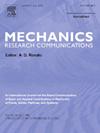Investigation of chemical corrosion influence on the mechanical behavior of rock-like materials by a micromechanics-based constitutive model
IF 2.3
4区 工程技术
Q3 MECHANICS
引用次数: 0
Abstract
The plastic deformation and damage generated during external loading or chemical reactions under corrosive environments have a significant influence on the macroscopic mechanical behavior of heterogeneous materials. In this work, a multiscale elastoplastic damage constitutive model is constructed for porous materials with and without chemical corrosion. Due to the external loading or the chemical corrosion, the material microstructure is changed. In this work, particular attention has been paid to the effect of material microstructure on the overall mechanical of heterogeneous material. The influence of porosity has been explicitly taken into account by a macroscopic yield criterion and it is treated as a damage factor. The asymmetric property of geomaterial between tension and compression has been considered by adopting the Drucker–Prager type criterion. By integrating the damage such as the new pores generated during the loading and also the chemical corrosion, a complete elastoplastic damage constitutive model is constructed. The performance of this multiscale model is fully studied. It is then applied to describe the macroscopic behavior of porous limestone in the case with/without chemical corrosion, and validated by the comparisons with experimental results under different confining pressures.
基于细观力学的本构模型研究化学腐蚀对类岩石材料力学行为的影响
在腐蚀环境下,外载荷或化学反应过程中产生的塑性变形和损伤对非均质材料的宏观力学行为有重要影响。本文建立了具有和不具有化学腐蚀的多孔材料的多尺度弹塑性损伤本构模型。由于外部载荷或化学腐蚀,材料的微观结构发生了变化。在这项工作中,特别关注了材料微观结构对非均质材料整体力学性能的影响。在宏观屈服准则中明确考虑了孔隙度的影响,并将其视为损伤因素。采用Drucker-Prager型准则考虑了岩土材料的拉压不对称特性。将加载过程中产生的新孔隙和化学腐蚀等损伤综合起来,建立了完整的弹塑性损伤本构模型。对该多尺度模型的性能进行了充分的研究。然后将其应用于描述多孔灰岩在化学腐蚀和非化学腐蚀情况下的宏观行为,并与不同围压下的实验结果进行对比验证。
本文章由计算机程序翻译,如有差异,请以英文原文为准。
求助全文
约1分钟内获得全文
求助全文
来源期刊
CiteScore
4.10
自引率
4.20%
发文量
114
审稿时长
9 months
期刊介绍:
Mechanics Research Communications publishes, as rapidly as possible, peer-reviewed manuscripts of high standards but restricted length. It aims to provide:
• a fast means of communication
• an exchange of ideas among workers in mechanics
• an effective method of bringing new results quickly to the public
• an informal vehicle for the discussion
• of ideas that may still be in the formative stages
The field of Mechanics will be understood to encompass the behavior of continua, fluids, solids, particles and their mixtures. Submissions must contain a strong, novel contribution to the field of mechanics, and ideally should be focused on current issues in the field involving theoretical, experimental and/or applied research, preferably within the broad expertise encompassed by the Board of Associate Editors. Deviations from these areas should be discussed in advance with the Editor-in-Chief.

 求助内容:
求助内容: 应助结果提醒方式:
应助结果提醒方式:


